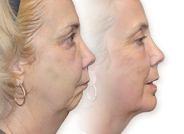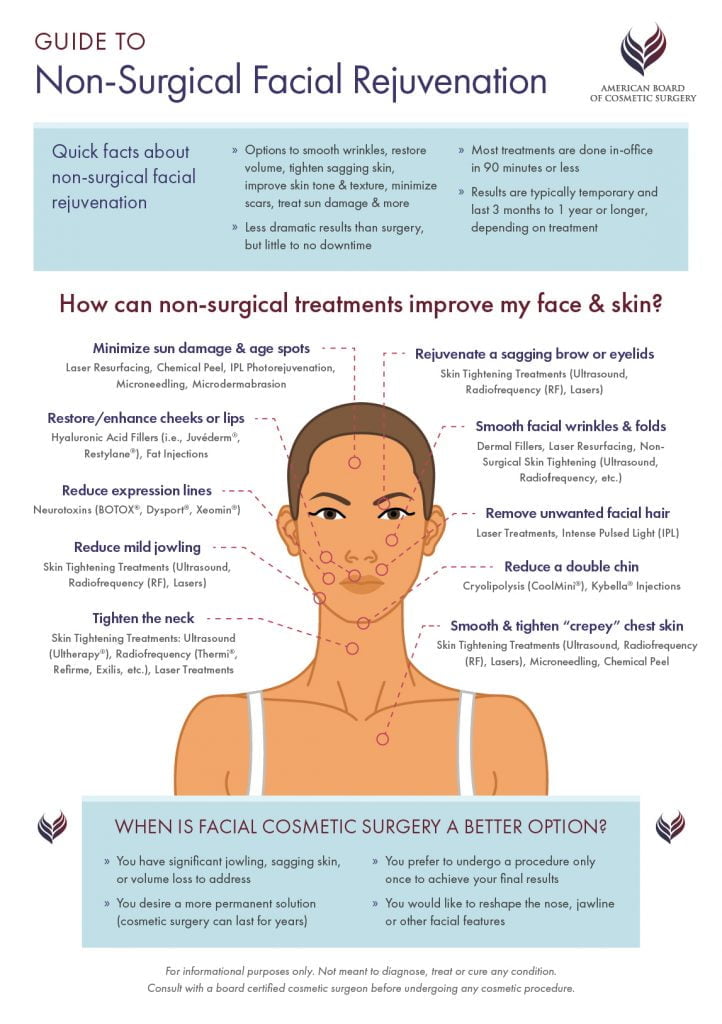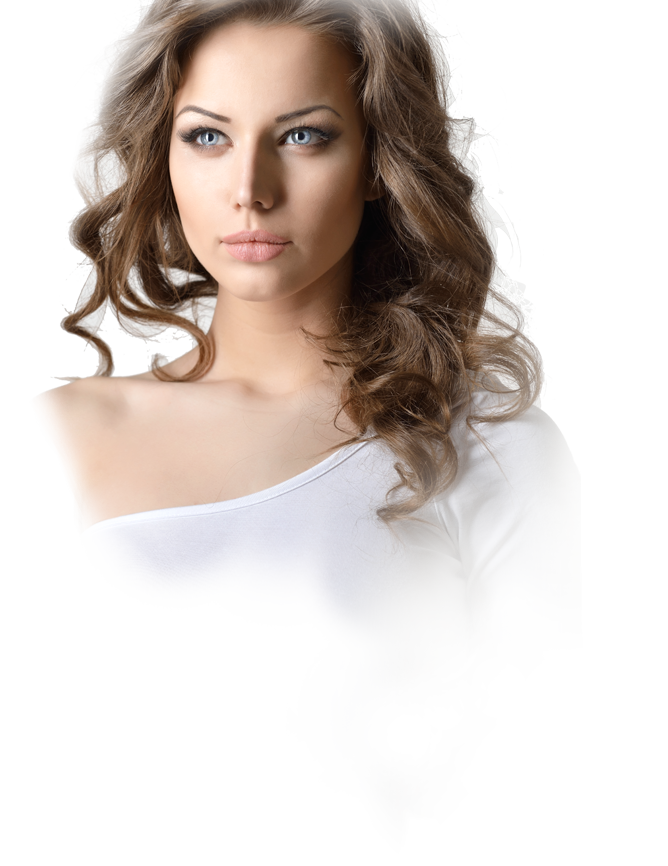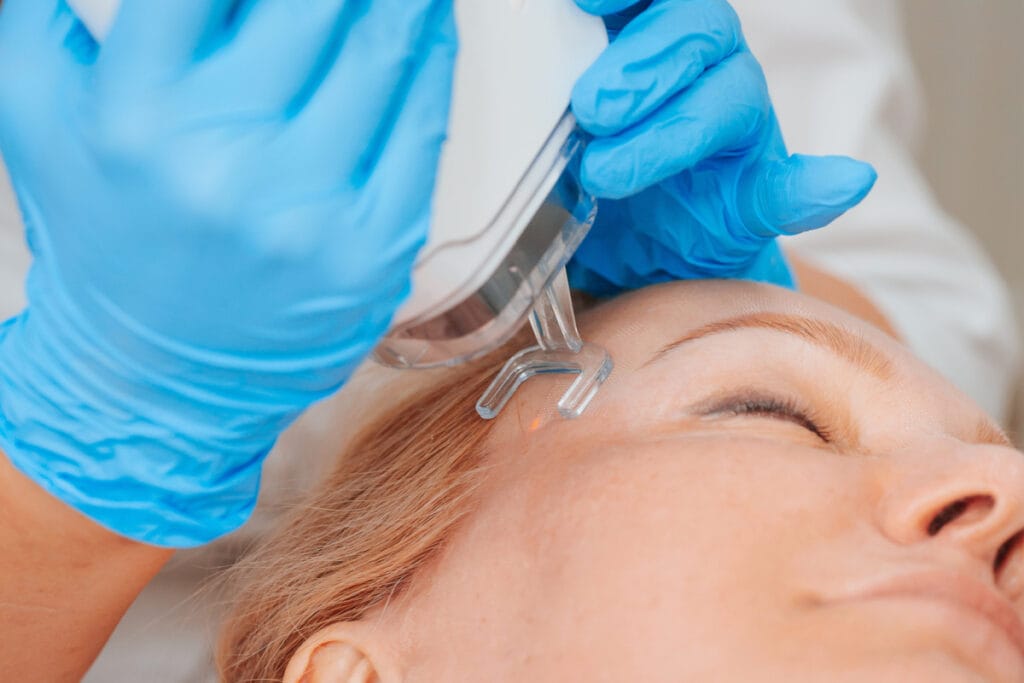
What is skin resurfacing?
Skin resurfacing treatments help to restore a more youthful, beautiful complexion by removing the most damaged outer layers of skin to reveal the healthier-looking skin beneath and encouraging new, healthy skin cell growth.
Over time, our skin’s outer layers start to show wear and tear from aging, injury, and environmental factors in the form or wrinkles, scars, age spots and discoloration. Skin resurfacing treatments help to reverse these signs of aging and stress, helping you look younger, and even healthier, in the process.
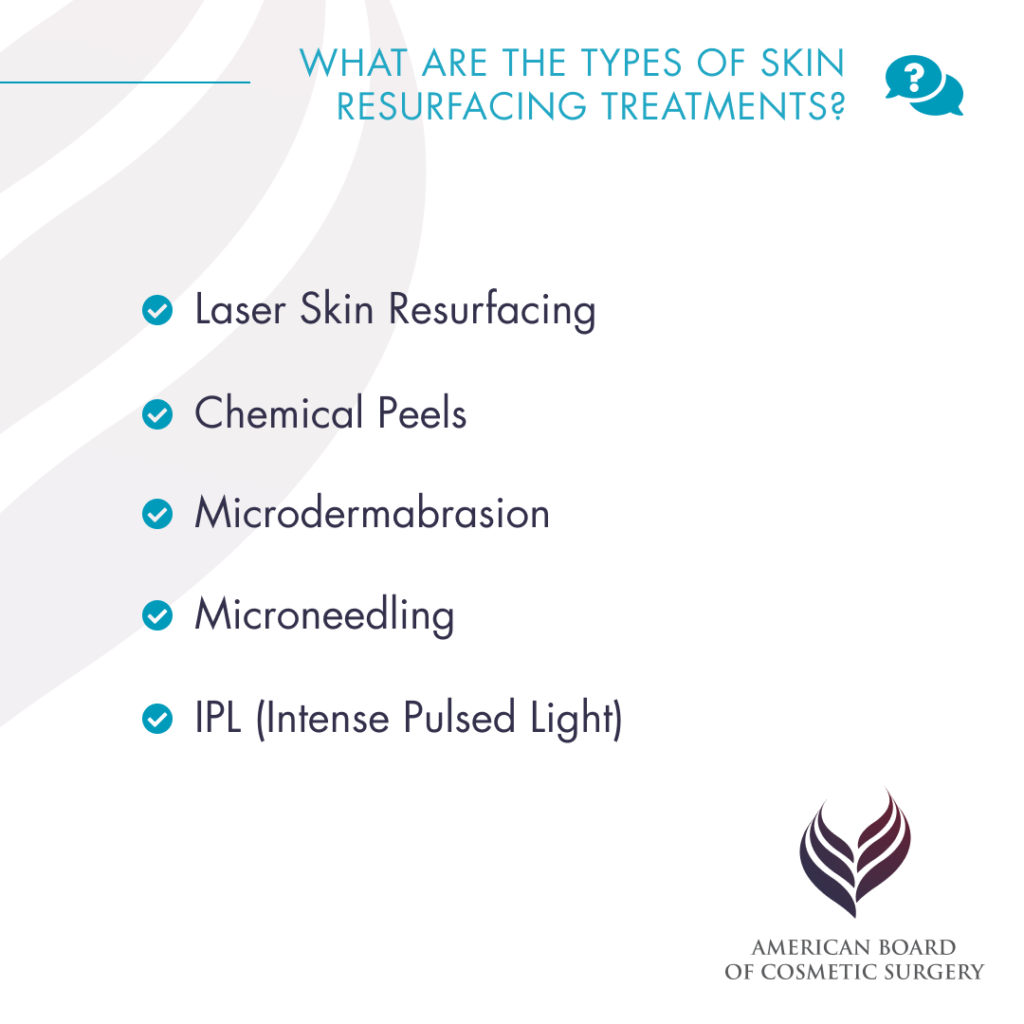
Cosmetic surgeons use a variety of techniques for skin resurfacing to address a myriad of skin concerns. Choose from the list below to learn more about your options:
- Who should perform skin resurfacing treatments?
- Non-Surgical Facial Rejuvenation: an Infographic Guide
- Skin Resurfacing Treatments
Who should perform skin resurfacing treatments?
There are literally hundreds of different skin resurfacing treatments available in the U.S., which are marketed under their own brand names. While most of these are excellent technologies, it is important to remember that the component of cosmetic medicine that has the biggest impact on your results is your provider. This goes for non-surgical skin resurfacing treatments as well as cosmetic surgery.
Certain skin resurfacing treatments should only be performed by a board certified cosmetic surgeon. These include deep chemical peels and certain ablative laser treatments. Other treatments, such as microneedling, light peels, and microdermabrasion, can be safely and effectively performed by a highly trained registered nurse or licensed aesthetician.
The credentials required to perform skin resurfacing treatments vary from state to state, but regardless of what is allowed in your area, you should always choose a provider who is licensed for his or her position, works under the supervision of a qualified cosmetic surgeon (if the provider is a nurse or aesthetician) and is very experienced in medical skin care. When you consult with potential providers, ask how many times he or she has performed the specific treatments you are considering. Additionally, ask about the provider’s experience working with patients with your skin type and concerns. This is essential for your safety and to ensure the treatments you receive will be effective in achieving your goals.
The best place to start is to contact a board certified cosmetic surgeon in your area and set up a consultation with that surgeon and/or their skin care director. You can use our Find-A-Surgeon Tool to locate cosmetic surgeons near you.
- Key Benefits
- Glossary
- Improves skin texture: Skin resurfacing procedures, such as chemical peels and laser resurfacing, can improve skin texture by removing dead skin cells and stimulating collagen production.
- Reduces wrinkles: In addition to improving texture, skin resurfacing can also reduce the appearance of wrinkles and fine lines by promoting collagen growth and smoothing out skin irregularities.
- Reduces scars and blemishes: Skin resurfacing can also be effective in reducing the appearance of scars and blemishes, creating a more even complexion.
- Skin tone: The color and evenness of the skin, which can vary due to factors such as genetics, sun exposure, and pigmentation.
- Skin elasticity: The ability of the skin to stretch and return to its original shape, influenced by collagen and elastin fibers.
- Collagen: A protein found in the skin that provides structural support and strength.
- Ablative: Referring to a type of laser treatment or procedure that removes or vaporizes the outer layers of the skin, typically resulting in more significant downtime and potential side effects.
- Non-ablative: Referring to a type of laser treatment or procedure that targets deeper layers of the skin without removing the outer layers, resulting in minimal downtime and fewer side effects.
- Laser treatment: The use of laser technology to target specific skin concerns such as wrinkles, pigmentation, and texture irregularities.
- Pigmentation: The coloration of the skin caused by the presence of melanin, which can lead to variations in skin tone and the appearance of spots or patches.
- Epidermis: The outermost layer of the skin, responsible for protection and barrier function.
- Hyperpigmentation: The darkening of certain areas of the skin, often caused by an overproduction of melanin, resulting in patches or spots that appear darker than the surrounding skin.
- Dynamic wrinkles: Wrinkles that form as a result of facial muscle movements and expressions, such as crow’s feet or smile lines.
- Static wrinkles: Wrinkles that are present even at rest, often caused by a loss of collagen and elastin as well as the natural aging process.
- Fractionated laser: A laser treatment that delivers energy in a fractionated pattern, targeting only a portion of the skin, which promotes faster healing and reduces downtime compared to traditional ablative lasers.
- Carbon dioxide (CO2) laser: A type of ablative laser that emits short bursts of high-energy light to vaporize the outer layers of the skin, commonly used for skin resurfacing and wrinkle reduction.
- Photofacial: A cosmetic treatment that uses intense pulsed light (IPL) or other light-based technologies to target pigmentation issues, redness, and improve overall skin tone.
Non-Surgical Facial Rejuvenation Options: an Infographic Guide to Your Options
Non-surgical facial rejuvenation includes injectable fillers, neurotoxins, and skin tightening as well as skin resurfacing. Many cosmetic surgeons will combine treatments to achieve optimal, long-lasting results. The guide below outlines all of your options.
Laser Skin Resurfacing Treatments
Lasers use highly concentrated beams of light energy to improve the skin’s tone, texture and appearance.
How can laser skin resurfacing improve my skin?
- Minimize fine lines or wrinkles
- Treat brown spots, redness or discoloration for more balanced skin tone
- Tighten skin and encourage collagen production
- Remove acne or surgical scars
- Remove unwanted facial or body hair
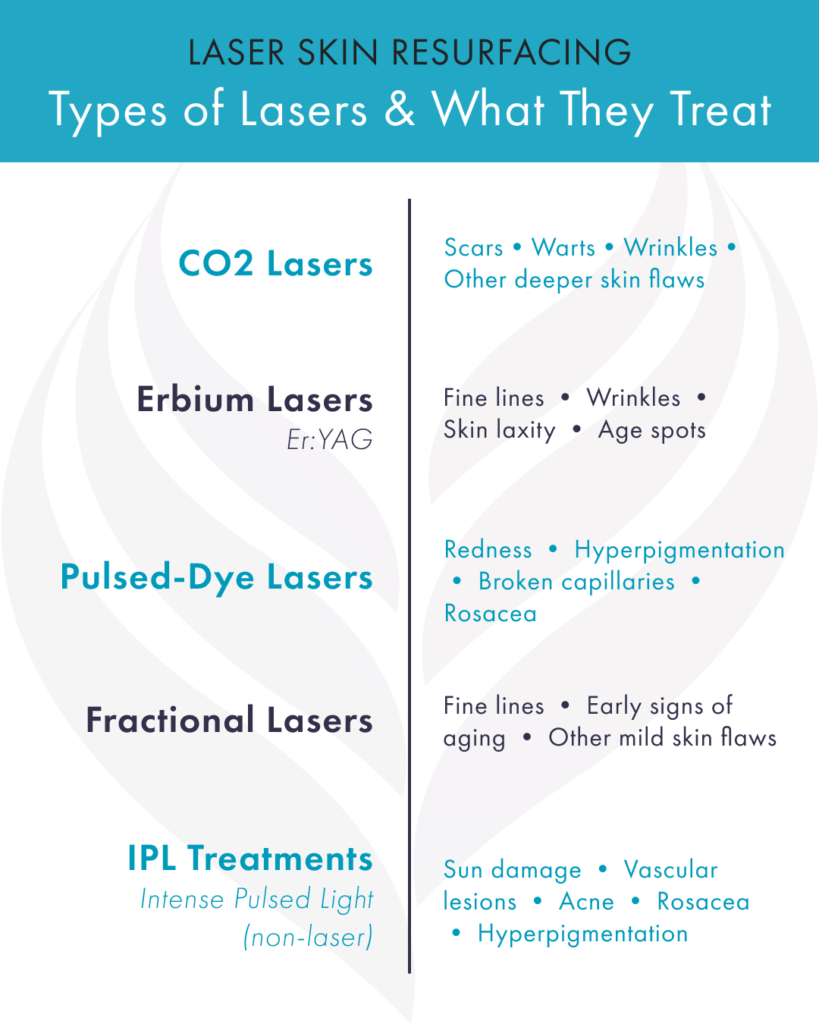
Ablative Lasers
Ablative lasers remove outer layers of skin and encourage new skin to heal in its place. How deep the laser penetrates depends on the wavelength of the light; your cosmetic surgeon will determine the best laser application for you depending on your skin type, your goals, and the nature of the problem you wish to address. Today, more cosmetic surgeons are using fractionated lasers, which only remove a fraction of the skin in the treatment area. This allows the laser to safely penetrate into the deeper layers of skin to achieve more dramatic results with minimal downtime.
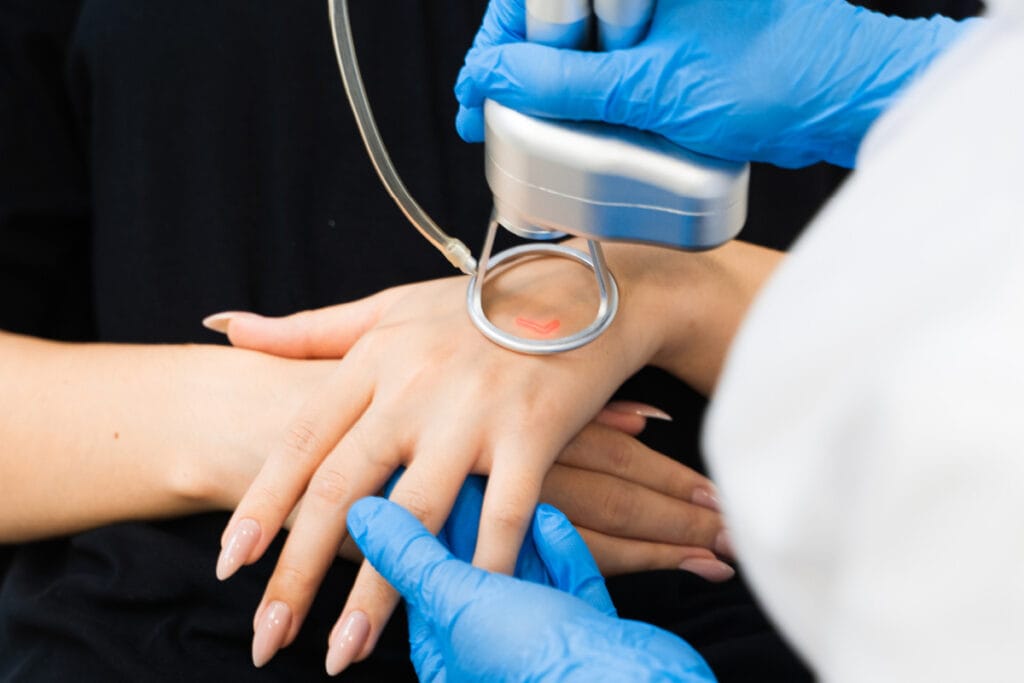
Non-Ablative Lasers
Some lasers do not break the skin’s surface; these are called non-ablative. They work instead by heating up the skin below the surface to encourage new collagen growth and help restore the skin’s natural firmness and tone. While they work more gradually than ablative lasers, these treatments typically require no downtime and can have lasting results for rejuvenating the appearance.
The improvements possible with laser resurfacing are long-lasting and can be dramatic, but they will not appear overnight. It takes several months for the full effects of new skin cell and collagen growth to take shape, and residual after-effects of treatment, such as skin that appears pink at the treatment site, can take a few weeks to subside. However, every patient is a little different. Your cosmetic surgeon will help you learn what type of results you might expect from different laser resurfacing treatment options.
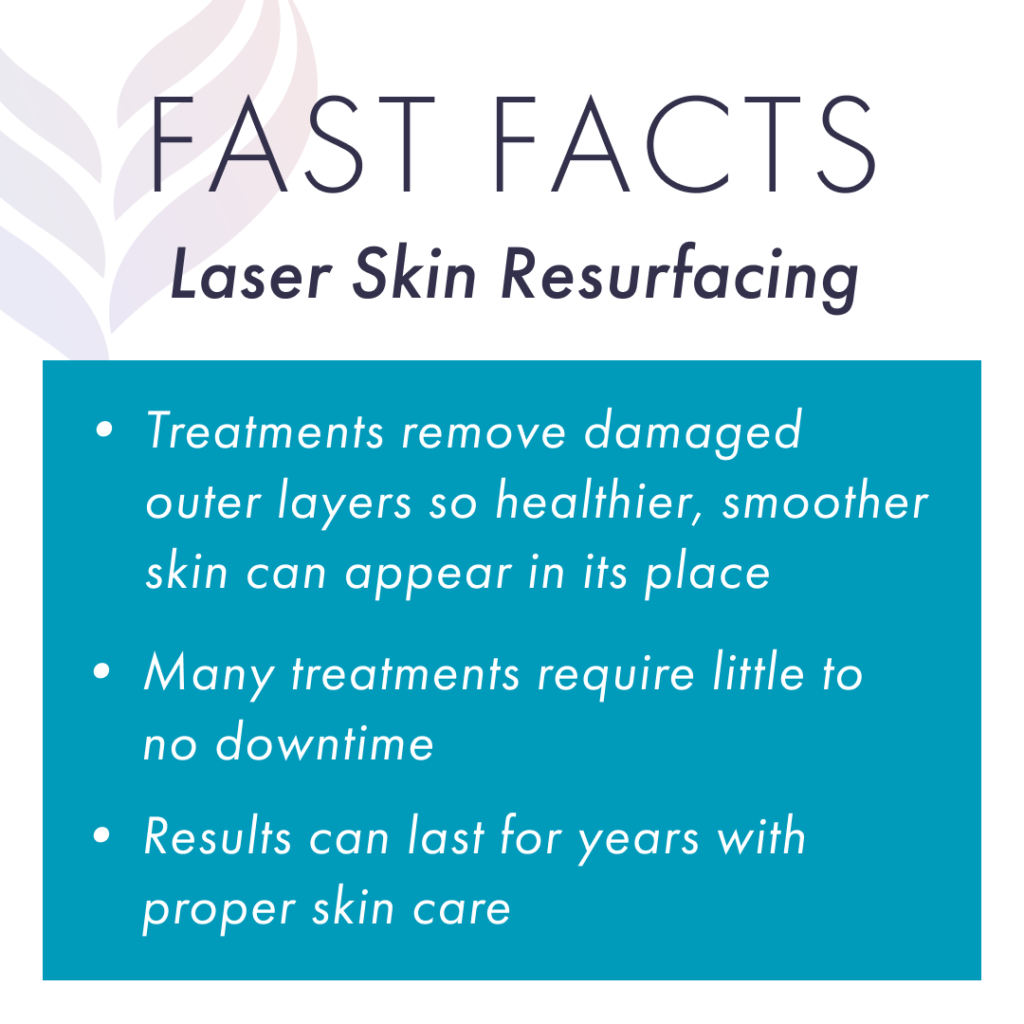
Chemical Peels
Another way to resurface the skin is to apply a chemical solution that causes the outer layers of skin to peel away. This is what cosmetic surgeons call a chemical peel. Chemical peels are usually performed in a cosmetic surgeon’s office, either by the cosmetic surgeon or a specially trained aesthetician or nurse. During treatment, a solution is brushed or swabbed onto your skin, where it will be left for a certain period of time. Over the days following treatment, the affected layers of skin will gradually peel away, revealing a smoother, younger-looking complexion.
How can a chemical peel help improve my skin?
- Reduce or remove age spots, blotchiness, or discoloration
- Smooth fine lines & wrinkles on the skin’s surface
- Minimize or remove acne scars or milder scars from injury or surgery
- Tighten & tone the skin and brighten the complexion
- Remove keratoses or precancerous growths
Light vs. Deep Chemical Peels
Depending on the treatment, a peel will often be classified as light, medium, or deep. This refers to how many layers of skin are removed. Light chemical peels will typically reach partially through the epidermis (the outermost layers of skin) and use a milder acid solution such as glycolic acid, alpha hydroxy acid (AHA), salicylic acid, fruit enzymes, or a low concentration of trichloroacetic acid (TCA). Light peels can be safely applied by a trained, experienced aesthetician under the supervision of a cosmetic surgeon, and typically involve little to no downtime.
Deeper peels will reach further into the epidermis or even into the next layer, the dermis, and are recommended to address more advanced signs of aging, such as deeper wrinkles and extensive sun damage, or severe acne scars. Examples include phenol peels, stronger TCA peels, and croton oils. While medium to deep peels can produce more dramatic improvements, they are more involved treatments. Anesthesia may be needed to keep a patient comfortable during treatment, and several days of downtime are required to allow the skin to heal optimally.
Your cosmetic surgeon will recommend a peel based on your skin type, the specific issues you want to address, and how deep the peel needs to work to achieve the desired results. After the initial healing period following a chemical peel, some improvements will be immediately noticeable: brighter, tighter-feeling skin and a more even skin tone. However, the effects of a peel are cumulative, and many patients find repeating treatment periodically is needed for optimal results.
Microdermabrasion & Dermabrasion
A third class of skin resurfacing treatments are those that involve mechanical exfoliation, where an instrument is used to slough off outer layers of skin to remove visible skin damage and reveal smoother, healthier and younger looking skin. Such treatments include microdermabrasion and dermabrasion. While they have similar sounding names, each of these treatments works quite differently.
Microdermabrasion
Microdermabrasion is a relatively gentle procedure that can be used on the face, neck, hands or body. During treatment, the area is exfoliated by using a very fine tipped instrument or by applying a fine mist of abrasive particles. The exfoliated skin is then immediately vacuumed away. Unlike some other resurfacing treatments, microdermabrasion is safe for all skin types, carries very little risk for side effects, and requires no downtime.
What can microdermabrasion do to improve skin?
- Minimize fine lines & wrinkles, such as crow’s feet
- Help skincare products work more effectively
- Brighten skin & improve tone
- Reduce age spots or mild acne scars
Microdermabrasion can be performed in the same sessions as a peel or facial to enhance the results. While immediate improvements are usually noticeable, microdermabrasion treatments are often performed in a series to achieve optimal improvements. It is also essential to protect the treated area from the sun, as skin will be more sensitive to sun damage after microdermabrasion.
Dermabrasion
Dermabrasion is a more powerful mechanical resurfacing technique than microdermabrasion. During treatment, a cosmetic surgeon will use a rapidly rotating instrument or blade to precisely remove skin from the treated area layer by layer until the desired depth. Because it reaches more deeply into the skin’s surface, dermabrasion can affect skin pigmentation, and thus is not recommended for every skin type. Typically, patients will receive a topical anesthetic or local anesthesia to ensure comfort during and after the procedure.
What can dermabrasion do to improve skin?
- Minimize vertical lip lines, smile lines, or other facial wrinkles
- Remove acne scars and other blemishes
- Smooth the skin and balance complexion
The purpose of dermabrasion is to remove enough layers of skin to remove the visible concerns and encourage new cell growth. Therefore, the area will be tender and “raw” after treatment. It is essential to keep the area well protected from the sun and follow your cosmetic surgeon’s instructions for keeping the skin free from infection.
Under the care of a qualified, experienced cosmetic surgeon, skin resurfacing treatments can reverse the visible effects of aging to dramatically enhance a patient’s appearance.
Microneedling
Microneedling is a skin resurfacing technology that uses the skin’s natural healing process to reduce skin imperfections, treat sun damage, and restore a smoother, clearer complexion. Instead of removing layers of skin with heat or chemicals, microneedling creates microscopic “injuries” in the skin using an instrument containing dozens of very fine, short needles. The “injuries” are not visible to the naked eye, but they do trigger the natural healing response, prompting your skin to produce new collagen and elastin and regenerate new, healthy skin cells.
What skin concerns can microneedling treat?
- Fine lines & wrinkles
- Acne or surgical scars
- Large pore size
- Sun damage, age spots and hyperpigmentation
- Stretch marks
- Rough patches & texture problems
Since microneedling does not remove layers of skin with chemicals or lasers, it is generally safe for all skin types, even darker skin. Additionally, microneedling requires no downtime for most patients, and does not require a post-treatment “peeling” period. However, results may not be as dramatic as what is possible with more aggressive treatments, and multiple microneedling treatments are usually needed to treat specific skin concerns in an area.
IPL (Intense Pulsed Light)
Intense pulsed light, or IPL, is a treatment similar to laser resurfacing in that it uses light to treat skin problems, particularly pigmentation problems, and rejuvenate the complexion. However, instead of a highly focused, single wavelength, IPL uses a broad spectrum of light wavelengths, delivered in brief pulses. This light helps the skin in two ways. First, the wavelengths in IPL absorb excessive pigment in the skin (reds and browns) to restore a more even complexion. To a lesser degree, IPL stimulates collagen production to improve overall skin tone. IPL is a non-ablative treatment (no skin is removed during treatment), and typically requires little to no downtime.
What skin concerns can IPL treat?
- Sun damage
- Hyperpigmentation
- Age spots & freckles
- Spider veins
- Redness & rosacea
- Vascular lesions
- Texture problems
- Fine lines
IPL is marketed under many different names, including BBL (broad band light), photofacial, and photorejuvenation. However, while individual treatment platforms vary somewhat in their specifications, all use a broad-wavelength intense pulsed light technology—the skill of your provider makes a bigger difference in your treatment than the brand name of the treatment.
References »
Mehta-Ambalal SR. Neocollagenesis and Neoelastinogenesis: From the Laboratory to the Clinic. Journal of Cutaneous Aesthetic Surgery. 2016. doi: 10.4103/0974-2077.191645
Singh A, Yadav S. Microneedling: Advances and widening horizons. Indian Dermatology Online Journal. 2016. doi: 10.4103/2229-5178.185468.
Husain Z, Alster TS. The role of lasers and intense pulsed light technology in dermatology. Clinical, Cosmetic and Investigational Dermatology. 2016. doi: 10.2147/CCID.S69106.
Heidari Beigvand H, Razzaghi M, Rostami-Nejad M, Rezaei-Tavirani M, Safari S, Rezaei-Tavirani M, Mansouri V, Heidari MH. Assessment of Laser Effects on Skin Rejuvenation. Journal of Lasers in Medical Sciences. 2020. doi: 10.34172/jlms.2020.35.
DeLisi MP, Schmidt MS, Hoffman AF, Peterson AM, Noojin GD, Shingledecker AD, Boretsky AR, Stolarski DJ, Kumru SS, Thomas RJ. Thermal damage thresholds for multiple-pulse porcine skin laser exposures at 1070 nm. 2019. doi: 10.1117/1.JBO.25.3.035001.
Heidari Beigvand H, Razzaghi M, Rostami-Nejad M, Rezaei-Tavirani M, Safari S, Rezaei-Tavirani M, Mansouri V, Heidari MH. Assessment of Laser Effects on Skin Rejuvenation. J Lasers Med Sci. 2020. doi: 10.34172/jlms.2020.35.
